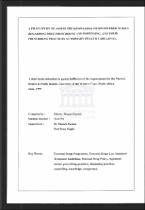| dc.contributor.advisor | Puoane, Thandi | |
| dc.contributor.author | Daniels, Felicity Megan | |
| dc.date.accessioned | 2022-08-30T10:11:47Z | |
| dc.date.available | 2022-08-30T10:11:47Z | |
| dc.date.issued | 1999 | |
| dc.identifier.uri | http://hdl.handle.net/11394/9272 | |
| dc.description | Master of Public Health - MPH | en_US |
| dc.description.abstract | Introduction : Nurses working at Primary Health Care (PHC) level are expected to prescribe and dispense drugs according to the Essential Drugs List (EDL) and the Standard Treatment Guidelines (STGs), in an effort to promote rational drug use. Post-basic training courses such
as Adult Curative for PHC provides knowledge and skills needed to practise drug therapy, however, not all nurses have attended these courses. Many registered nurses are therefore not competent to participate in the strategy of Health for All through Primary Health Care. The purpose of this study is to determine whether registered nurses at PHC level are applying the concept of rational drug use in their daily work. Aims : To assess the knowledge of registered nurses regarding drug prescribing and dispensing, and their prescribing practices at PHC level. To determine whether are were differences in the practices in urban, peri- urban and rural areas. Methodology : An indicator form was used to review the prescribing practices of registered nurses. Self administered questionnaires were completed by the nurses. Study population : All registered nurses working at Primary Health Care facilities. Sampling : The area of study was stratified into urban, peri-urban and rural. Four clinics were randomly selected from each area. A total of 100 prescriptions per clinic were selected through systematic random sampling. Purposive sampling of all registered nurses. Data Analysis : Quantitative analysis was done using Epi - Info version 6.0 and Microsoft Excel. Means, frequencies, ranges, percentages and p-values were calculated. Results : The average number of drugs prescribed per encounter and the percentage of prescriptions with injections were low. The percentage of drugs prescribed on the EDL and the
percentage of prescriptions using generic names were also low. Interesting significant differences were noted in the prescribing practices in urban, peri-urban and rural areas. Conclusion : Irrational prescribing and dispensing by registered nurses at PHC level is still a major problem and reflects the need for appropriate training. | en_US |
| dc.language.iso | en | en_US |
| dc.publisher | University of the Western Cape | en_US |
| dc.subject | Essential Drugs Programme | en_US |
| dc.subject | Essential Drugs List | en_US |
| dc.subject | Standard Treatment Guidelines | en_US |
| dc.subject | National Drug Policy | en_US |
| dc.subject | Registered nurses | en_US |
| dc.subject | Prescribing practices | en_US |
| dc.subject | Dispensing practices | en_US |
| dc.subject | Counselling | en_US |
| dc.subject | Knowledge | en_US |
| dc.subject | Competence | en_US |
| dc.title | A pilot study to assess the knowledge of registered nurses regarding drug prescribing and dispensing, and their prescribing practices at primary health care level. | en_US |
| dc.rights.holder | University of the Western Cape | en_US |

